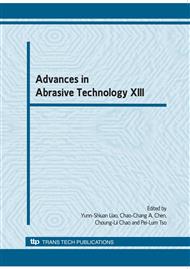p.353
p.361
p.367
p.375
p.381
p.388
p.394
p.401
p.407
Study on Application of Taguchi Method to Ultrasonic-Aided Spin Welding of Heterogeneous Plastic Materials
Abstract:
The Taguchi Method was applied in this study to discuss the mechanical strength of heterogeneous plastic materials by ultrasonic-aided spin welding. Two heterogeneous plastic workpieces were rotated by a high speed motor, to make the top of conducting energy angle generate the high temperature due to friction. When the thermoplastic material reached the heat distortion temperature, a proper pressure was exerted on another material, the surface would be welded in a semi-melted state. Then the process conditions of ultrasonic welding were arranged by using the standard orthogonal table of Taguchi Method, and the temperature of the contact friction surface could be increased by the excitation of ultrasonic transducers as well as magnified and displaced by sound wave welding head. The optimal value of tensile strength was obtained by using the Large-the-Best characteristic of the Taguchi Method to obtain the important control factors of this experiment; a validation experiment was carried out by using the adjusted factors.
Info:
Periodical:
Pages:
381-387
Citation:
Online since:
August 2010
Price:
Сopyright:
© 2010 Trans Tech Publications Ltd. All Rights Reserved
Share:
Citation:


